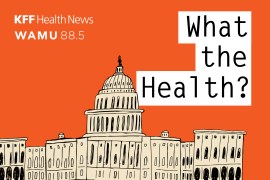As Shutdown Risk Rises, Democrats Demand Health Care Policy Changes
Democrats are eyeing a repeal of the Medicaid cuts passed in July and a long-term extension of expiring Obamacare tax subsidies. Meanwhile, Politico reports that President Donald Trump's health care cuts may be felt sooner rather than later.
Bloomberg:
Risk Of US Government Shutdown Rises With Democratic Counteroffer
An increasingly rancorous standoff over funding the US government intensified Wednesday as congressional Democrats swung big on a counteroffer, ratcheting up the risk of an Oct. 1 shutdown. Democrats are demanding President Donald Trump and congressional Republicans agree to health care policy changes that House Speaker Mike Johnson has said have “zero” chance of becoming law as part of the spending bill. (Wasson, 9/17)
Politico:
Democrats’ Shutdown Endgame Is Sketchy As Deadline Looms
Democrats are gearing up to reject a GOP stopgap funding bill and potentially spark a government shutdown. What happens then, no one seems to know. Two weeks ahead of the key deadline, party leaders are staking out a rhetorical hard line demanding that their Republican counterparts come to the negotiating table to discuss concessions on health care and other issues. (Wu and Carney, 9/18)
Also —
Politico:
Trump’s Health Care Cuts May Hit Voters Sooner Than He Thinks
The conventional wisdom in Washington is that by pushing off big changes to Medicaid until after the 2026 midterms, Republicans shielded themselves from voter backlash. Don’t be so sure. A full year before anyone casts their vote in November 2026 — meaning now, in the fall of 2025 — the American health care system will begin transitioning from an era of unprecedented expansion of coverage to an era of unprecedented cutbacks. And President Donald Trump and the GOP-controlled Congress will be easy to blame. (Kenen, 9/18)
More about health care costs and insurance coverage —
Modern Healthcare:
PBM Bill Will Pass This Winter: Rep. Buddy Carter
Bills to limit pharmacy benefit managers have been among the most popular and bipartisan pieces of legislation introduced in Congress during the last two years, yet none have passed. Is this finally the year? The House passed the Lower Costs More Transparency Act of 2023 with a PBM provision in the last Congress. The Senate, however, only advanced PBM bills as far as committee consideration. (McAuliff, 9/17)
AP:
Amazon Spends $1 Billion To Increase Pay And Lower Health Care Costs For US Workers
Amazon says it’s investing more than a $1 billion to raise wages and lower the cost of health care plans for its U.S. fulfillment and transportation workers. The Seattle-based company said Wednesday the average pay is increasing to more than $23 per hour. Some of its most tenured employees will see an increase between $1.10 and $1.90 per hour. Full-time employees, on average, will see their pay increase by $1,600 per year. Amazon also said it will lower the cost of its entry health care plan to $5 per week and $5 for co-pays, starting next year. (D’Innocenzio, 9/17)
Modern Healthcare:
Nursing Home Occupancy Rates Rise, But Discharge Issues Remain
Nursing homes are emerging from a years-long financial funk as more beds are filled, but that can make things tougher for health systems eager to discharge patients. Occupancy at skilled nursing facilities is ramping up to pre-pandemic levels as staffing stabilizes and growth in the number of people over age 65 ratchets up demand. That, in turn, is leading to higher margins for some nursing homes. But facilities are being cautious about how they add beds — and how they fill them — in the face of rising costs, leaving some hospitals in a tough spot. (Eastabrook, 9/17)
Becker's Hospital Review:
Safety-Net Hospital Funding Hinges On Widely Varying Definitions: 7 Things To Know
Funding for safety-net hospitals relies on definitions that vary significantly, leading to big differences in which facilities qualify for support and how resources are distributed, according to a recent study from the University of Pennsylvania’s Leonard Davis Institute of Health Economics. Seven things to know: 1. Definitions vary widely. Researchers applied nine definitions of safety-net hospitals to data from more than 4,500 acute care hospitals. Depending on the definition used, anywhere from 992 to more than 1,300 hospitals qualified, capturing as few as 2% or as many as 69% of rural hospitals. (Condon, 9/17)
Modern Healthcare:
Where Medicare Advantage Ratings Stand Ahead Of 2026 Release
The Centers for Medicare and Medicaid Services is not scheduled to publicly release the Medicare Advantage Star Ratings for several weeks. The drama, however, already has begun. On Sept. 9, the Centers for Medicare and Medicaid Services provided insurers with a private preview of their individual ratings, but accidentally disclosed every company’s preliminary rating in the file, according to sources familiar with the matter. (Tepper, 9/17)






